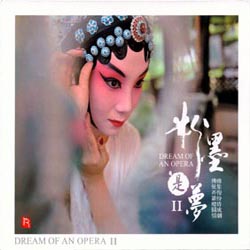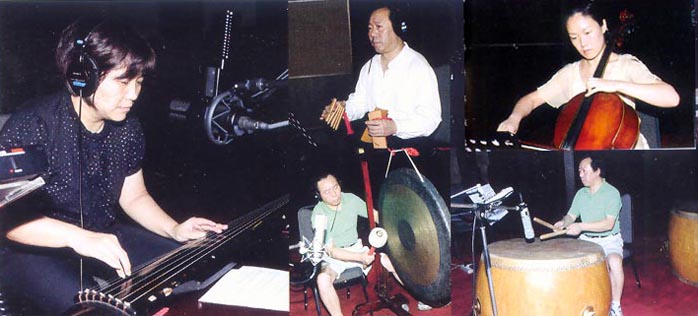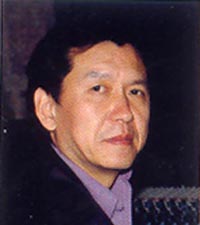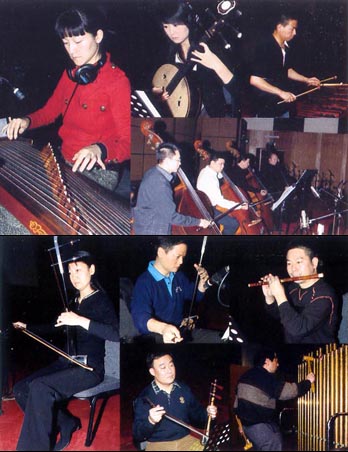 |
||||||||
 |
||||||||
Album Title: Dream of An Opera I & II Performers: Chinese traditional instrumentalists/Huang Li Jie, leader/China National Symphony Orchestra/China Philharmonic Orchestra Label and #: BlueSkyMusic Rhymoi Music RXRCD-004 / RMCD-G010 Play Time: 54'48" / 50' 56" Recorded: 2007/2008 Liner Notes: Album I: Overview and introduction in Chinese and English. Album II: Detailed program notes in Chinese and English My mother was born into a wealthy traditional Chinese family in Shantou (conventionally known as Swatow). She was the smallest of eight children and spoiled by everyone in the family. She grew up with operas -- the family could afford hiring a small local opera company to perform in-house every week -- until the national party warlords came. Few landlords survived those days. Owner of the power utility company, her father was no exception. After losing everything, her mother fled to Hong Kong with her and one older brother where they subsequently endured three years and eight months of Japanese occupation. My mother eventually met my father and started a new life. When we were small, Chinese operas were abundant and affordable. They came in many different forms and were sung in different dialects. The major forms are Yue, Chao (my mother's hometown opera), Huangmei, Peking (Beijing) and Cantonese opera. Those coexisted in live performances and movies. My mother was then able to renew her dreams of operas once more. And we were lucky to share those dreams. Huangmei operas fast became her favorite thanks to the many movies popularizing them. She had collected about ten LPs of complete soundtracks but gave them to friends before we emigrated to Canada. When I played these CDs to her during one weekend here, she was able to recall fond memories. To my surprise, even I could sing along with some Huangmei and Cantonese operas, which feature Mandarin and Cantonese lyrics respectively. |
||||||||
 |
||||||||
 |
||||||||
 |
||||||||
But today's reviewed CDs are wordless operas. They are condensed and arranged by esteemed opera composer Meng Qing Hua into a sinfonia concertante for traditional Chinese instruments with symphonic orchestral accompaniment. I'm always cautious with music that labels itself East Meet West or Silk Road but I would not hesitate to recommend these albums. Chinese operas, unlike Western operas, focus more on lyrics than melodies. There's nothing creative about Chinese melodies since the arias and duets seldom change. So yes, we recycle the melodies from one Huangmei opera to another. Ditto for Cantonese and Peking operas. Listening through one authentic performance could be sonically challenging for Western opera-goers. But when such operas are distilled down into five minutes with appropriate traditional instruments cast for the designated roles backed by dramatic orchestration, the effect can be as moving as The Ring without words. Mind you, while the melodies are hundreds of years old and never change, they are lovely, memorable melodies in their own right. |
||||||||
 |
||||||||
|
|
||||||||
| In Album II, my favorite starts with Woodcutter Liuhai (Huagu opera). Perhaps the most rustic form of operas in China, Huagu first started in villages and is known for its many light percussion instruments that make this number a cheerful country dance. The Cowherd and the Weaving Maid (Huangmei opera) is a similar story to The Cowherd and the Weaver Girl of Album I, another Huangmei opera. The music is totally different though. I'm more familiar with the latter since I've seen the movie. Hence the former has more novelty value. Lady General Mu Takes Command (Lu opera) has no relation with Mulan. Her full name was Mu Guiying, daughter-in-law of a Yang family whose three generations of male descendants had all died in battlefields resisting decades of Khitan invasions. In this patriotic number pulsating with solemn drum beats, Mu puts on her armor and leads the army. Last but not least is perhaps the most popular Cantonese opera of all, The Princess Chang Ping, daughter of the last emperor of the Ming dynasty. It's so popular that I remember the lyrics of this famous duet word for word. The melody is filled with heart-wrenching melancholy. On the night of her wedding, the young princess was ordered killed by the emperor together with the entire royal family while the capitol was besieged by invading armies. The princess miraculously survived to be reunited with her bridegroom some years later. The new Qing dynasty ordered the couple back to the capitol. In this duet, they complete their wedding ceremony before committing suicide. |
||||||||
 |
||||||||
| I am a Chinese opera-goer by birth, a Western opera fan by choice. Yet these albums are now among my treasured collection. Unlike certain traditional Chinese music recording, these albums are imbued with the elegance of classic beauty and a scholarly refinement in the arrangement as well as interpretations. The Chinese traditional instrumentalists are all at the top of China today. Song Fei (Erhu, banhu, gaohu), Zhang Qiang (pipa, ruan, willow lute), Dai Ya (di, bamboo flute), Du Cong (Shakuhachi), Zhang Jing (guzheng)... the list goes on. There's not one overpowering note, not one over-excited sound. Music flows from the heart like poetry. And the sound engineers and post-production team (JVC of Japan) fully respected that and did a great job preserving the fine tonal balance yet remained truthful to sonic tactility. This music is meant to touch the heart, not arouse the senses. It's a world-class recording of Chinese music that even a defector like me can feel proud of. While it's harder for me to tell you which one to get if you are thinking of trying just one, my personal preference leans towards Album II for the love of Lady General Mu and Princess Chang Ping. You probably wouldn't fall in love with every track instantly. Give them time to grow on you just like they have grown on me. |
||||||||
 |
||||||||